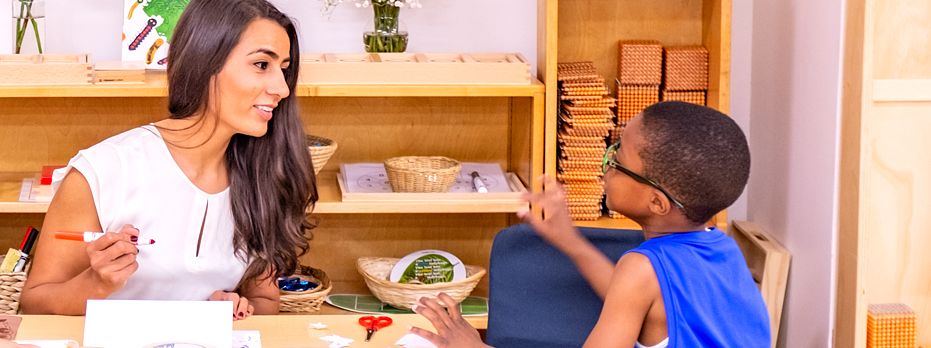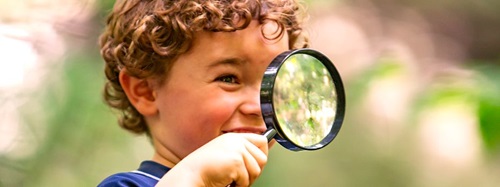The Big Questions
Discovering the Heart of Great Teaching
|
November 2014
What do you think of when you hear the word “child”? How would you define your role in the classroom? How do young children learn? These are some of the big questions that are crucial to a teacher’s understanding of and commitment to teaching and learning but are rarely addressed in depth.
In the field of education, teachers are constantly being told what they should do with children in a classroom. They are inundated with new curricula packages, child assessment rubrics, Quality Rating and Improvement Systems (QRIS), and activities that purport to promote children’s learning. But teachers have little opportunity to explore for themselves the most important questions at the heart of great teaching. These questions are the foundation upon which they grow in the art and practice of their craft. It is through ongoing reflection and action that teachers become competent, empowered, and energized by their work.
What is your image of the child?
Perhaps the most important question teachers need to ask themselves is, “What do I think of when I think of the word ‘child’?” Or as they ask in Reggio Emilia preschools, “What is your image of the child?” I have asked this question of many college students majoring in early childhood education. The responses are telling. Students have replied, “pure, innocent, vulnerable, cute, sponges, and sweet.” They used negative descriptions as well, “manipulative” being one of the most common. Of course, I rejoiced at responses that included, “curious, bright, energetic, lively, strong, inventive, and imaginative.” This initial big question, however, afforded my students and me the opportunity to explore the implications of their responses.
What are those implications and why is this important? If you think of children as innocent and cute, how will you talk with them? Will you take their ideas seriously? Will you listen closely to the deeper feelings being expressed? What sorts of materials will you provide and will you allow them to take reasonable risks?
If you think that children learn like sponges, soaking up information from the outside, without contributing their own understanding, thoughts, and feelings, then how will you approach learning? Will you decide to give them the words, ideas, and facts instead of allowing them to discover?
If you first think of “manipulative” when you hear the word “child,” does that preclude a genuine relationship between the teacher and children? Will there be such an absence of trust that children’s movements will be restricted?
How you view children will have a direct impact on how you talk with them, what happens in your classroom, and what sort of environment you create. If you respect children’s thinking and ideas, you will listen intently to what they say and build on those ideas. You will be curious and, instead of constantly doing, you will step back to watch and listen in order to better understand. You will want to know more. You will develop a relationship that is based on genuine interest and kindness. The environment and routine will be flexible enough to follow the children’s lead, to be spontaneous, and to allow time for discovery. Having teachers reflect on their attitudes and beliefs about children should be the first step in a teacher’s education.
What is your role?
A teacher’s attitude about children will play a big part in how she defines her own role in the classroom and, therefore, it is important for teachers to ask, “Who do I want to be in the lives of children?” Teachers often refer back to their own memories of elementary school when embarking on a teaching career. Did that model of teacher make sense, then or now? Do you think of yourself as an instructor/manager of a classroom, or do you think of yourself as a co-researcher, continually learning along with children? What words would you use to describe your role in working with children? Without giving this considerable thought, teachers can easily become technicians, simply following a set of guidelines, allowing someone else to define who they are and what they believe.
How do we learn?
Then teachers need to ask, “How do young children learn?” Do they learn by being provided with information, worksheets, crafts, and activities, or do they learn best by constructing their own learning, playing with other children and exploring with the teacher as she coaxes or observes? But asking the question is not enough. The teacher must also examine evidence gathered from many sources, including her own observations and working knowledge. She must ask, “How do I know?”
The danger in not asking questions
There is a real danger in not asking these questions. If teachers rely solely on the dictates of others, they can never really distinguish between what is good for children and what is not. They are too busy following guidelines, standards, and assessments from outside sources that do not know the particular children in their classrooms and, in fact, may not truly understand the way that young children learn. Taking so much time completing assessments, checklists, and doing to children leaves teachers with less time to observe and be with children. When teachers are required to tick off activities, crafts, or skills, there is less time available to be involved while children play and explore in nature, pretend and imagine stories, and spontaneously follow the BIG questions that will propel them to deep learning.
Questioning and learning together
Teachers would do well to grapple with these questions, to continually assess their work and take time to share ideas and thoughts with colleagues. Schools and preschools need to provide space and time for teachers to learn the way we all (children and adults) learn best—through play, discussion, and inquiry with colleagues—in a safe, supportive environment. Perhaps states and governing bodies that mandate teachers to add STEAM (Science, Technology, Engineering, Art, Mathematics), literacy, or whatever else to their classrooms should provide the means for teachers to create space and time for ongoing collaborative work and self reflection. If the teacher only knows teaching and learning based on a set of curriculum guidelines or worse, a scripted curriculum, the children will gain very little in the way of deep learning or becoming confident learners. However, if the teacher is curious about the world around her and about the children with whom she works and is afforded the time to question with colleagues, the classroom will benefit by leaps and bounds. How? The teacher will be a role model, exhibiting her curiosity and interest in the children while sharing discoveries. Her inquisitiveness and disposition to keep learning can only influence the children in the most positive ways. She will have the time to know each child more intimately and then be able to provide the tools and materials, guidance, and nurturance that suit her particular children. In turn, the children will thrive and become even more of their amazing selves.
Paulo Freire said it best: “Knowledge emerges only through invention and re-invention, through the restless, impatient, continuing, hopeful inquiry human beings pursue in the world, with the world, and with each other.”






